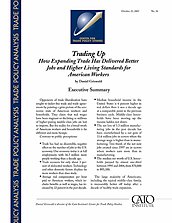Opponents of trade liberalization have sought to indict free trade and trade agreements by painting a grim picture of the economic state of American workers and households. They claim that real wages have been stagnant or declining as millions of higher-paying middle-class jobs are lost to imports. But the reality for a broad swath of American workers and households is far different and more benign.
Contrary to public perceptions:
- Trade has had no discernible, negative effect on the number of jobs in the U.S. economy. Our economy today is at full employment, with 16.5 million more people working than a decade ago.
- Trade accounts for only about 3 percent of dislocated workers.Technology and other domestic factors displace far more workers than does trade.
- Average real compensation per hour paid to American workers, which includes benefits as well as wages, has increased by 22 percent in the past decade.
- Median household income in the United States is 6 percent higher in real dollars than it was a decade ago at a comparable point in the previous business cycle. Middle-class households have been moving up the income ladder, not down.
- The net loss of 3.3 million manufacturing jobs in the past decade has been overwhelmed by a net gain of 11.6 million jobs in sectors where the average wage is higher than in manufacturing. Two-thirds of the net new jobs created since 1997 are in sectors where workers earn more than in manufacturing.
- The median net worth of U.S. households jumped by almost one-third between 1995 and 2004, from $70,800 to $93,100.
The large majority of Americans, including the typical middle-class family, is measurably better off today after a decade of healthy trade expansion.

This work is licensed under a Creative Commons Attribution-NonCommercial-ShareAlike 4.0 International License.

